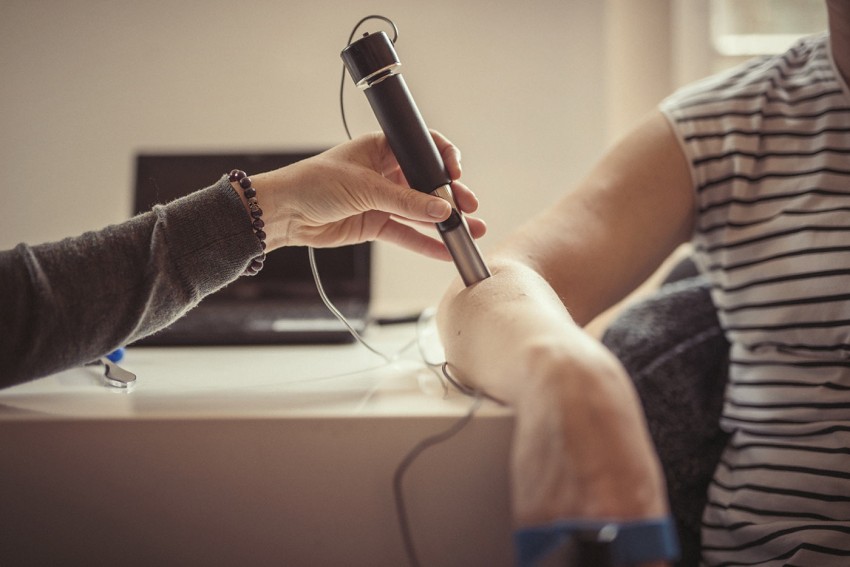THYROFLEX
AboutThe patented Thyroflex is a non-invasive state of the art system to test, diagnose, and manage thyroid conditions using reflexes and symptoms to accurately determine Thyroid function. It allows the practitioner to test the patient’s physiological functions, accurately evaluate the patient’s health status and assign treatment. It is estimated that 80% of the population has a thyroid disorder.
Spiraling medical costs have forced many medical practitioners to reduce the number of screening tools available to their patients as well as the time they spend with their patients. Not only does the THYROFLEX address cost concerns for both the practitioner and the patient, it also offers pain-free, noninvasive convenient testing options with immediate feedback.
All Thyroid blood tests are not accurate in determining the thyroid function. The only way to determine thyroid disease is from reflexes and symptoms. – according to Sir Dr. R. I. S. Bayliss a famous Endocrinologist with the foremost Lister Hospital in London, England, Endocrinologist to the British Royal Family
Thyroflex
The Application
Only 18% of the thyroid hormone can be found in the blood. The chances of detecting thyroid disorders in the blood are low because it is not comprehensive enough. It is estimated that 80% of the population has a thyroid disorder.
A blood test measures only the TSH levels, which have limited value in diagnosing thyroid conditions. The TSH levels measured traditionally determine the ‘ideal’ dose of thyroid medication, so it is not surprising that most often patients still remain symptomatic, as blood tests are not a valid medium to determine thyroid function. Many individuals have “normal” TSH levels but suffer from the classic symptoms of hypothyroidism. Most physicians require objective evidence before diagnosing hypothyroidism on the basis of a patient’s clinical symptoms when their blood tests fall within the “normal” range. These sub-clinical hypothyroidism individuals are often denied treatment that would help them manage their condition and symptoms.
Unlike the blood test, the Thyroflex tests the end artifact of the thyroid function (FT3) and it has a 98.5% accuracy rate. The Thyroflex test measures the neurotransmitter speed (brain function), the reflex speed and the resting metabolic rate (RMR). It also takes into account the “Core Hormones” i.e. stress hormones (Cortisol, GABA, DHEA, D3), sleep hormones, Iodine and CoQ10. For this reason, Thyroflex Thyroid Testing is most feasible for making a diagnosis and for determining the optimal dose of thyroid medication for symptomatic patients.
Thyroflex
The Science
Slow Reflexes
The connection was made late in the 19th century when doctors studying patients with Hypothyroidism observed that clinically hypothyroid individuals have very slow or absent tendon reflexes. The speed at which this reflex reaction occurs is an indicator of cellular function. The lower the speed of conduction, the lower the cellular energy and function.
Cellular function is ultimately controlled by T3, the most biologically active thyroid hormone. Low levels of T3 in the cells result in diminished cellular function, which ultimately causes the clinical symptoms of Hypothyroidism. Since blood tests cannot measure the level of intracellular T3, one way to objectively test cellular function is by measuring the speed at which a nerve impulse is conducted through nerve and muscle cells. Thyroid disorders tend to run in families, therefore it is usually hereditary. In medical school, we are all taught that the reflexes speed up and slow down with thyroid function.
Thyroflex
The Development
Historical overview of Reflex testing with Achilles
One of the oldest tests for hypothyroidism was the Achilles tendon reflex test in which the rate of relaxation of the calf muscle corresponds to thyroid function. The relaxation is slow in hypothyroid people. Exactly the same slow relaxation occurs in the hypothyroid heart muscle, contributing to heart failure, because the semi-contracted heart can’t receive as much blood as the normally relaxed heart. The hypothyroid blood vessels are unable to relax properly, contributing to hypertension. Hypothyroid nerves don’t easily return to their energised relaxed state, leading to insomnia, parasthesias, movement disorders, and nerves that are swollen and very susceptible to pressure damage.
“The thyroid hormone keeps the cellular energy high, the adrenaline low, and reflexes strong. It undoubtedly has an important effect on both perception and responses. Checking the relaxation rate of the Achilles reflex is a quick way to check the effect of the thyroid on your nerves and muscles. The relaxation should be instantaneous, loose and floppy. There are several convenient indicators of the metabolic rate, the daily temperature cycle, and pulse rate (the temperature should rise after breakfast), the amount of water lost by evaporation, and the speed of relaxation of muscles (Achilles reflex relaxation). Measuring the speed and relaxation of the Achilles tendon reflex twitch is a traditional method for judging thyroid function, because in hypothyroidism the relaxation is visibly delayed”.
Woltman’s Sign Achilles
Delayed relaxation of the muscle stretch reflex (Woltman’s Sign) occurs in hypothyroidism. The Achilles tendon reflex is a scientific way to assess thyroid function. The foot should plantar flex quickly and then return immediately to its starting position or beyond with no hesitation if the metabolism is healthy. No response or a very slow return back to original position are indicative of low metabolism.
Woltman’s sign of myxoedema, named after Henry Woltman in 1956, is the delayed relaxation phase of the muscle stretch reflex in patients with myxoedema. Although a change in these reflexes was mentioned as being clinically evident possibly as early as the 1870s, no formal description was published until 1924 when William Calvert Chaney objectively quantified the change. Woltman was involved in training Chaney, and it has been proposed that he guided Chaney’s study of these reflexes. Despite the attachment of Woltman’s name to the eponym, little evidence exists that directly links him to the first objective study of the muscle stretch reflex in myxoedema performed by Chaney.
Achilles to Brachioradialis
Dr. Turner, the inventor, creator, and Intellectual property holder of the Thyroflex, and the ‘Core Hormone’ system, the BioPharma Nutaceuticals, SAM Integrative software analysis for hormones, the Dr Referral System services, initially began development on the Thyroid Reflex research now called the Thyroflex focusing on the Achilles reflex. Then Dr. Turner moved the research and testing to the Brachioradialis, as a more practical test location, the Brachioradialis in the arm, for testing and screening of patients. The Achilles and the Brachioradialis are 99.9% correlated. Clinical trials were then completed over a three-year period on 2,200 people, testing not only the Reflex speed, but also the Neurotransmitters and the Resting Metabolic Rate. (RMR) When we combined the symptoms with the Thyroflex results we were able to offer to other medical practices a precise, integrated system to treat and help their patients with Thyroid disease. The results are proof in and of itself. The Thyroflex is peer reviewed, published, with FDA & CE registration.
The Nitek Thyroflex system has now tested over 1/3 million people, accurately identifying those at risk with thyroid disease. Treating the people identified with Thyroid disorders with the Nitek Core Hormone protocols and the BioPharma medications, and assisting these people to lead a symptom free quality of life. Dr. Turner also discovered in his research and clinical trial endeavors, how to identify Hashimoto’s, how to put it into remission, and how to eventually eliminate the autoimmune disorder helping tens of thousands of people to be auto immune free, and to enjoy life once again.
LET'S TALK ABOUT BLOOD
The TSH blood test is generally considered the most sensitive marker of peripheral tissue levels of thyroid. Many believe this view, however it is incorrect. Some endocrinologists and other physicians erroneously assume that, except for unique situations, a normal TSH is a clear indication that the person’s tissue thyroid levels are adequate (i.e. symptoms are not due to low thyroid). But a more thorough understanding of the physiology of hypothalamic-pituitary-thyroid axis and tissue regulation of thyroid hormones exposes it is clearly erroneous the widely held belief that the TSH is an accurate marker of the body’s overall thyroid status. Therefore, the TSH blood test is not a valid or accurate indicator of thyroid function.
A large study published in the Journal BMC Endocrine Disorders evaluated the accuracy of TSH by testing 2570 women attending a reproductive endocrine clinic for menstrual irregularities or infertility. The study found that the TSH was a very poor indicator of abnormal thyroid function as over half the women with a TSH between 2 and 4 mIU/L, which would be interpreted as indication of normal thyroid function, were shown to be hypothyroid when the more accurate and sensitive TRH testing was done.
A study published in the British Medical Journal examined the accuracy of using the TSH as a marker for adequate thyroid replacement. The study found that the TSH was a very poor indicator of optimal thyroid function, and that a suppressed TSH was not an accurate indicator of over-replacement. It was shown that 80% of the time a suppressed TSH was not an indication of hyperthyroidism or over-replacement, and the authors discourage the reliance on the TSH for optimal dosing.
One such study clearly demonstrating this fact was published in the Journal of Clinical Endocrinology and Metabolism. It was determined how often central hypothyroidism that was confirmed with TRH testing went undetected by standard thyroid function tests. The authors found that 92% of patients with hypothyroidism would have remained undiagnosed using baseline thyroid function tests (Blood tests). The authors conclude. “…most prior studies have failed to accurately identify many cases of hypothyroidism because diagnostic criteria require a T4 or FT4 value below the normal range in addition to a low TSH value. However, patients with hypothyroidism most often have normal TSH values and T4 or FT4 levels within the lower part of the normal range”.
Note: In our Resources, there is a comprehensive review of Blood testing with references, as to why the thyroid blood tests are not valid in determining Thyroid function. As Dr. R.I.S. Bayliss stated, none of the blood tests are valid, the only way to determine thyroid function is Symptoms and reflexes. The Thyroflex, uses symptoms and reflexes, with a 98.5% accuracy rate.
Thyroid Disorder
What Are The Symptoms?
Hypo
*_____ Tiredness & Sluggishness, lethargic
*_____ Dryer Hair or Skin (Thick, dry, scaly)
*_____ Sleep More Than Usual
*_____ Weaker Muscles
*_____ Constant Feeling of cold fingers/hands/feet
*_____ Frequent Muscle Cramps
*_____ Poorer Memory
*_____ More Depressed (mood change easily)
*_____ Slower Thinking
*_____ Puffier Eyes
*_____ Difficulty with Math
*_____ Hoarser or Deeper Voice
*_____ Constipation
*_____ Coarse Hair / Hair loss/Brittle
*_____ Muscle / Joint Pain
*_____ Low Sex Drive / Impotence
*_____ Puffy Hands and Feet
*_____ Unsteady Gait (bump into things)
*_____ Gain Weight Easily
*_____ Outer Third of Eyebrows Thin
*_____ Menses More Irregular (should be 28 days)
*_____ Heavier Menses (clotting / 3+ days)
*_____ Carpel Tunnel Syndrome
Hyper
*_____ Palpitations (Skipping of heart beat)
*_____ Insomnia
*_____ Tachycardia (Rapid or irregular heart beat)
*_____ Shakiness
*_____ Increased Sweating
*_____ Brittle Nails
*_____ Loss of Appetite
Thyroid Function Test
The Comparison
Standard
Medical Blood Test
Blood Panel
- Misleading and inaccurate, in classifying the patient with sub-clinical hypothyroidism. 18% accurate
- Costly, out of office blood test, requires 2nd visit
- No revenue to your practice
- Measures only the TSH levels or sometimes T3, T4, and on rare occasions FT3, FT4 in the blood which have limited value in diagnosing thyroid conditions
- Not able to identify or provide optimal treatment for a Hypothyroidism, Hyperthyroidism, RT3, and Autoimmune not identified
- Subjective
- There is no treatment offered for the symptomatic patients
Advanced
Thyroflex Test
Thyroid Function Test
- 98.5% accuracy rate. Non-invasive, pain-free with fast results
- Cost Effective, in house test and instant results.
- Revenue to your practice
- Measurement of conduction velocity through tendon reflex, RMR, and takes into account the evaluation of the symptoms
- Able to diagnose, treat and titrate, Euthyroid, Hypothyroidism, Hyperthyroidism, Autoimmune and RT3
- Objective Evidence
- Optimal dose of thyroid medication for symptomatic patients
The Process
ThyroflexThe Thyroflex tests for thyroid conditions and further assists in the medical analysis of potential health conditions. The analysis and treatment is integrated through the revolutionary SAM (Software for Age Management). SAM provides health history, health forecasts, health condition management and treatment recommendations as a complete solution. Upon completion of the Thyroflex test, it determines whether the patient is hypothyroid, hyperthyroid, or euthyroid. The results are then uploaded into the SAM system for the next steps to prescribe the treatment according to the thyroid levels.
The thyroid medication needs to be “titrated”, which means to adjust the medications slowly every 30 days until the correct dosage is determined. From historical literature, this means the average patient will be on two to three grains of natural bio identical thyroid (Biothroid), as our protocols recommend you take the patient up one grain at a time, (30 days to equilibrate) this means that the patient would have three to four visits, to be titrated, to dose. Once at dose, we recommend that you allow one repeat (90 days) then retest the patient every 6 months. All of our Nutraceuticals are FDA compliant.

Thyroflex Testing Device

Thyroflex Software Solution
The Process Overview
ThyroflexWe recommend that an initial basic blood test is given to the patient, to check some of the blood markers that can affect the thyroid such as ferritin. Usually about 15% of patients tested require extra blood tests to further assess autoimmune disease, Hashimoto’s, or Graves disease and RT3.
Upon receiving the results, these disorders will require very specific protocols and treatment programs, that have been developed by Nitek. Our protocols first line of defense is to use all natural Bio identical medications. The thyroid medications will be titrated slowly until the correct dose is achieved. Most of the patients start to feel the effects of the medications within 14 days, some patients feel their best when they reach the correct dosage of medications. (For vegetarians, the natural bio identical thyroid hormones we use have no meat connective tissue or fat product in them, only the active Thyroid hormones are extracted, and purified, as a chemical compound).
1. Register patient and complete the online questionnaire 0 %
2. Perform Thyroflex Test (4 mins) 0 %
3. Upload Thyroflex Report to the SAM Software and input other biomarkers 0 %
4. View instant results and review condition management 0 %
5. Review automated treatment recommendation 0 %
6. Print report, provide APP credentials and provide products 0 %
FOR MORE DETAILS ON THE ENTIRE PROCESS FLOW >
THYRODINE
Nitek has the Thyrodine to accurately measure Blood Urine and Saliva. The Thyrodine is an iodine testing system, available on the same basis as the Thyroflex. The test takes one minute. It gives you a Parts Per Million reading in urine that indicates whether the patient is sufficient or deficient. It also gives you parts per million for saliva. Saliva indicates if the patient is up taking the BioDine or if halides or goitrogens are binding to the iodine.



